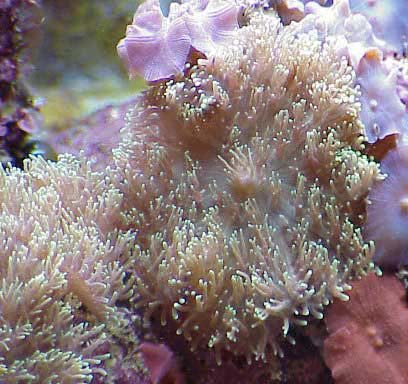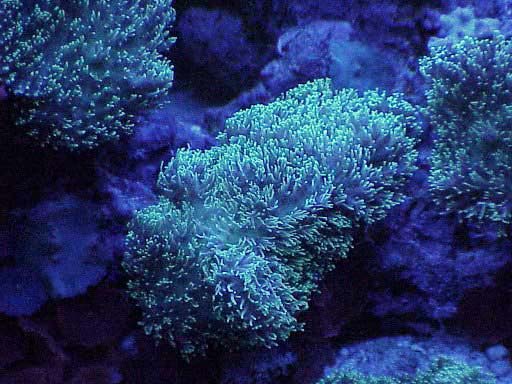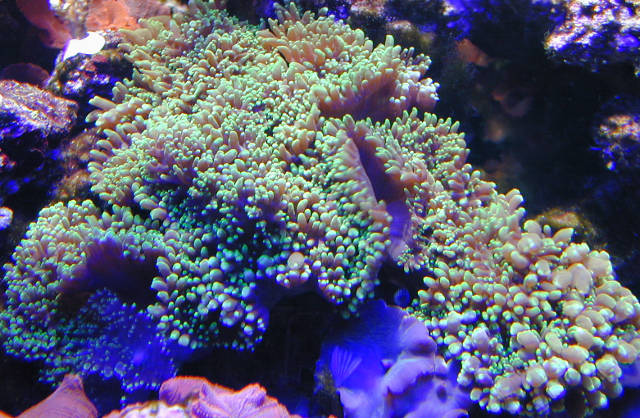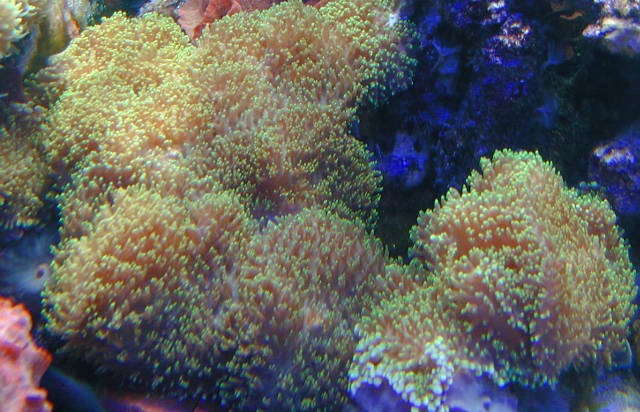
Rhodactis cf. indosinenis
Picture taken March 1999, Sony Mavica FD91 digital camera, no flash These mushrooms were purchased on January 1st, 1998. With regular full spectrum lighting these mushrooms have a faint green tint to them. However under actinic lighting they are a brilliant bright metallic green. Almost blinding! (See below) They do not reproduce as fast as other mushroom anemones. My original colony of 3 has reproduced to 6 in a little over a year. |

Rhodactis cf. indosinenis
Picture taken April 1999, Sony Mavica FD91 digital camera, no flash These mushrooms are easy to care for. They like low water currents and intense light. When I first got them I attempted directly feeding these anemones with small chunks of shrimp or silversides. The anemones accept it and the spit them out within a few minutes. I never tried direct feeding these again. Update: 6/5/1999 - One of these mushrooms attempted to spawn. An egg sack was released.
Date: June 05, 1999 Aprox time noticed: 12:30am
I'm happy to report, this morning while trying to feed my anemone I noticed an odd sack over my green frilly mushrooms. I was trying to figure out what it ate so I grabbed a flash light (lights were off for 2 hours already).. wow.. it was a sack of what looks like eggs. Mushrooms are "Rhodactis cf. indosinenis" as best I can ID them. They are frilly and each little frill looks just like a hand with a green glove on it. The mushroom in question was overly inflated, whereas the others were all very small (typical night time size). The sack was still attached to the mushroom by a strand or string of some type linked to the mouth. The eggs are in a tight mass of about 1/2" inch round. Grey in color. Individual eggs are clearly defined and can't really tell what holds them together. A few have come loose. They are small, not sure how to describe size of each one. My ruler doesn't have marks that small. No signs of sperm from the other mushrooms. Not taking a chance on the eggs being poisonous I removed the sack into a cup of water. I did my best to take pictures of them with my old 35mm, don't have my Mavica FD91 digital camera handy tonight. I could not get the 35mm camera to focus on such small little eggs. Manual focus was useless also. The eggs are in a plastic cup and the ball of eggs is coming apart and individual eggs are falling to the bottom of the cup. I'm going to aerate the cup lightly as guess on what to do and see if something more useful is suggested. This was documented on the Breeders Registry on June 7th, 1999. |

Rhodactis cf. indosinenis
Picture taken August 2000, Nikon CoolPix 950 digital camera, no flash The mushrooms are now several years old and they have gotten pretty large. They have not split much, I would say I have less then 10 of them and I have given a few away to friends. When fully expanded its hard to tell where one starts and another one ends, as far as mushrooms go these are some of the nicest looking ones I've seen. |

Rhodactis cf. indosinenis
Picture taken September 2001, Nikon CoolPix 950 digital camera, no flash The mushrooms have gotten larger and have divided to cover a greater area. I've actually had to kill some of them off as they were getting too close to near by SPS corals. A large bubble coral to the left side seems strong enough to be able to keep them away. |
